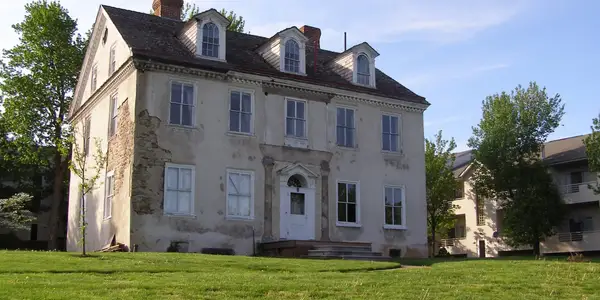Montgomery County's Historical Homes: A Journey Through Time
Welcome to Montgomery County, Pennsylvania, a region rich in history and charm. As we embark on a journey through time, we'll explore ten remarkable historical homes that have stood the test of time, each telling a unique story of the county's past. From colonial-era estates to Victorian mansions, these homes are a testament to Montgomery County's diverse and fascinating history.
Peter Wentz Farmstead
Located in Worcester Township, the Peter Wentz Farmstead stands as a testament to the rich heritage of German-American farmsteads. Dating back to 1758, this meticulously preserved farmhouse serves as a captivating window into the past, inviting visitors to immerse themselves in the distinctive architecture and lifestyle of the colonial era. As one explores the grounds, the historical significance of the farmstead becomes apparent, with its authentic features and period-specific details transporting guests to a bygone era. The site not only showcases the architectural prowess of the time but also provides a unique educational opportunity, offering insights into the agricultural practices, daily routines, and cultural nuances of 18th-century America. In essence, the Peter Wentz Farmstead stands as a living history lesson, weaving a narrative that connects present-day visitors with the fascinating tapestry of our colonial heritage.
Keith House At Graeme Park
Constructed in 1722, Graeme Park, situated in Horsham Township, serves as a historical gem and the erstwhile home of Sir William Keith, a distinguished colonial governor. This stately Georgian-style mansion is enveloped by verdant gardens, offering a picturesque setting that transports visitors to the opulence and refinement of 18th-century aristocratic life. As one meanders through the well-preserved halls of Graeme Park, they are treated to an immersive experience, replete with period-specific furnishings and architectural details that provide valuable insights into the lifestyle of the colonial elite. The estate's rich history, coupled with its elegant design, makes it a compelling destination for history enthusiasts and those seeking a connection to the cultural tapestry of the past. Graeme Park stands not just as a physical testament to a bygone era but as a vibrant reminder of the people and events that shaped colonial America.
Pottsgrove Manor
Built by John Potts, a figure of prominence in colonial times, the gracious Georgian mansion in Pottstown stands as a captivating portal into the opulent lifestyle of a colonial ironmaster. This meticulously crafted manor, characterized by its elegant Georgian architecture, opens its doors to visitors, providing an insightful peek into the daily life and opulence of its illustrious former owner. The interior boasts period rooms adorned with authentic furnishings, transporting guests back in time to an era of colonial grandeur. Furthermore, the mansion serves as a living museum, featuring exhibits that skillfully depict the social and economic history of the region, shedding light on the intricate tapestry of colonial life in Pottstown. The John Potts Georgian mansion, with its blend of architectural splendor and historical significance, is a testament to the legacy of a prominent colonial figure and the cultural heritage of the area.
John James Audubon Center at Mill Grove
Found in Lower Providence Township, the estate that once belonged to the celebrated naturalist and artist John James Audubon stands as a testament to the legacy of this iconic figure. Comprising a historic farmhouse and enchanting grounds, the property serves as a living chronicle of Audubon's life and his invaluable contributions to the field of ornithology. The historic farmhouse, where Audubon resided, offers a tangible connection to the past, allowing visitors to immerse themselves in the daily surroundings that inspired Audubon's groundbreaking work. As one stroll through the picturesque grounds, it becomes evident how the serene environment influenced Audubon's observations of birds and nature. This estate not only preserves the physical space Audubon once called home but also provides a unique opportunity for visitors to appreciate the profound impact he made on our understanding of the avian world and the natural beauty that surrounded him.
Pennypacker Mills
Surrounded by 170 acres of farmland in Perkiomen Township, the former residence of Pennsylvania Governor Samuel W. Pennypacker is an early 20th-century mansion that serves as a captivating showcase of architectural evolution. This stately abode adeptly captures the transition from the ornate Victorian style to the understated elegance of Colonial Revival architecture. As visitors explore the well-preserved rooms and corridors, they embark on a visual journey through time, witnessing the architectural shifts that mirrored the changing tastes of the era. The mansion's design, characterized by its meticulous attention to historical details, stands as a living testament to the governor's commitment to preserving the state's cultural heritage. Pennypacker Mills not only offers a glimpse into the life of a notable political figure but also provides a lens through which to view the broader societal changes reflected in the architectural landscape of the early 20th century.
Sunrise Mill
The Sunrise Mill is a historic grist mill complex that is located near Schwenksville in Upper Frederick Township, a 220-acre historic site situated along Swamp Creek in Upper Frederick, Lower Frederick, and Limerick, PA, boasts a diverse building complex as its centerpiece. The ensemble includes a gristmill, sawmill, house, barn, dam, and stone arch bridge, showcasing the region's agricultural and industrial history. Originating in 1767 with the construction of the gristmill by Michael Krause and Yost Bitting, the site evolved over the years, reaching its current size in 1870. A barn, erected in 1795 and bearing the initials of owners Jacob and Mary Shoemaker, adds a touch of historical charm. With the house added in 1828, overlooking the scenic Swamp Creek valley and hemlock groves, and a downstream stone arch bridge from 1845, the structures collectively represent 250 years of rural life in Southeast Pennsylvania.
The Speaker's House
The Speaker's House in Trappe, PA, served as the residence of Frederick Muhlenberg and his family from 1781 to 1803. Notably, Frederick Muhlenberg is recognized as the inaugural Speaker of the U.S. House of Representatives, a pivotal role he held during the First Congress. Additionally, he served as the speaker of the Third Congress. The historical significance of The Speaker's House lies in its connection to Muhlenberg's influential political career, marking a crucial period in the early years of the United States. As a tangible link to one of the country's founding figures, The Speaker's House stands as a testament to the enduring legacy of Frederick Muhlenberg and his contributions to American governance.
Henry Antes House
Built by Henry Antes in 1736, the Antes House stands as a well-preserved example of early German colonial architecture. The house served as a gathering place for evangelical and political meetings, fostering understanding among colonists of diverse backgrounds. It housed one of Pennsylvania's earliest interracial nonsectarian schools, established by the Moravian community. In 1963, The Goschenhoppen Historians, Inc., collaborated with the Girls Scouts of Philadelphia and the Antes Family Association to become stewards of the property. Designated a National Historic Landmark in 1992, the Henry Antes House now operates as a living history museum, showcasing mid-eighteenth-century plantation life during events like the annual Folk Festival.
Hope Lodge
Constructed between 1743 and 1748, Hope Lodge stands as a testament to the entrepreneurial spirit of Samuel Morris, a prosperous Quaker involved in various ventures such as farming, shipping, milling, iron production, and operating the mill later known as Mather Mill. This expansive estate, showcasing early Georgian architecture, is considered an exemplary creation of its time, with speculation that Edmund Woolley, the architect behind Independence Hall, may have provided guidance in its construction. Samuel Morris retained ownership of Hope Lodge until his passing in 1770, after which his brother Joshua inherited the estate. Subsequently, Joshua sold the property, including the distinctive dwelling, to another notable Philadelphia merchant, William West, marking a transition in the legacy of this historic landmark.
Located in Fort Washington!
Selma Mansion
Constructed in 1794, Selma Mansion stands as the former residence of General Andrew Porter and his family. General Porter, who served as a captain of marines during the Revolutionary War, later rose to the rank of Brigadier General in the Pennsylvania militia. Notably, he also held the esteemed position of Surveyor General of Pennsylvania. The historical significance of Selma Mansion extends beyond General Porter's military and civic contributions, as he is recognized as the great-grandfather of Mary Todd Lincoln, adding a familial link to one of America's most iconic First Ladies. General Porter's legacy continued through his son, David Rittenhouse Porter, a distinguished ironmaster and the 9th governor of Pennsylvania, marking the mansion as a key element in the tapestry of American history.
When embarking on a journey through Montgomery County's historical homes, consider checking with local historical societies, museums, or official websites for updated information on opening hours, guided tours, and any special events. Exploring these homes can provide a vivid understanding of the county's rich past and the individuals who shaped its history.
Whether you're a history enthusiast, a lover of architectural marvels, or someone seeking a home with character and charm, Montgomery County's historical homes await your exploration. And when you're ready to turn your historical home dreams into reality, trust The Shaina McAndrews Team to guide you through the process with expertise and dedication.












